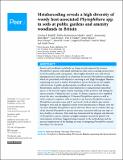Metabarcoding reveals a high diversity of woody host-associated Phytophthora spp. in soils at public gardens and amenity woodlands in Britain
Abstract
Forests and woodlands worldwide are being severely impacted by invasive Phytophthora species, with initial outbreaks in some cases occurring on host trees located in public parks and gardens. These highly disturbed sites with diverse planting practices may indeed act as harbours for invasive Phytophthora pathogens which are particularly well adapted to surviving in soil. High throughput Illumina sequencing was used to analyse Phytophthora species diversity in soil samples collected from 14 public garden/amenity woodland sites in northern Britain. Bioinformatic analyses revealed some limitations to using internal transcribed spacer as the barcode region; namely reporting of false positives and ambiguous species matches. Taking this into account, 35 distinct sequences were amplified across the sites, corresponding to 23 known Phytophthora species as well as twelve oomycete sequences with no match to any known Phytophthora species. Phytophthora pseudosyringae and P. austrocedri, both of which cause serious damage to trees and are regarded as fairly recent introductions to Britain, were the two most abundant Phytophthora species detected. There was no evidence that any of the detected Phytophthora species were more associated with any one type of host, healthy or otherwise. This study has demonstrated the ubiquity and diversity of Phytophthora species endemic in highly managed, extensively planted soil environments in Britain. Suggested improvements to the methodology and the practical implications of the findings in terms of mitigating Phytophthora spread and impact are discussed.
Citation
Riddell , C E , Frederickson-Matika , D , Armstrong , A C , Elliot , M , Forster , J , Hedley , P E , Morris , J , Thorpe , P , Cooke , D EL , Pritchard , L , Sharp , P M & Green , S 2019 , ' Metabarcoding reveals a high diversity of woody host-associated Phytophthora spp. in soils at public gardens and amenity woodlands in Britain ' , PeerJ , vol. 7 , e6931 . https://doi.org/10.7717/peerj.6931
Publication
PeerJ
Status
Peer reviewed
ISSN
2167-8359Type
Journal article
Description
This work was supported by Forestry Commission Scotland (grant number SLA-14/15-034), the Living With Environmental Change Phase 3 project ‘Phyto-Threats’ as part of the Tree Health and Plant Biosecurity Initiative (grant number BB/N023463/1) and the European Union’s Horizon 2020 research and innovation programme POnTE (Pest Organisms Threatening Europe) (grant number 635646). David E.L. Cooke, Pete E. Hedley, Leighton Pritchard, Peter Thorpe also received funding from the Scottish GovernmentCollections
Items in the St Andrews Research Repository are protected by copyright, with all rights reserved, unless otherwise indicated.

